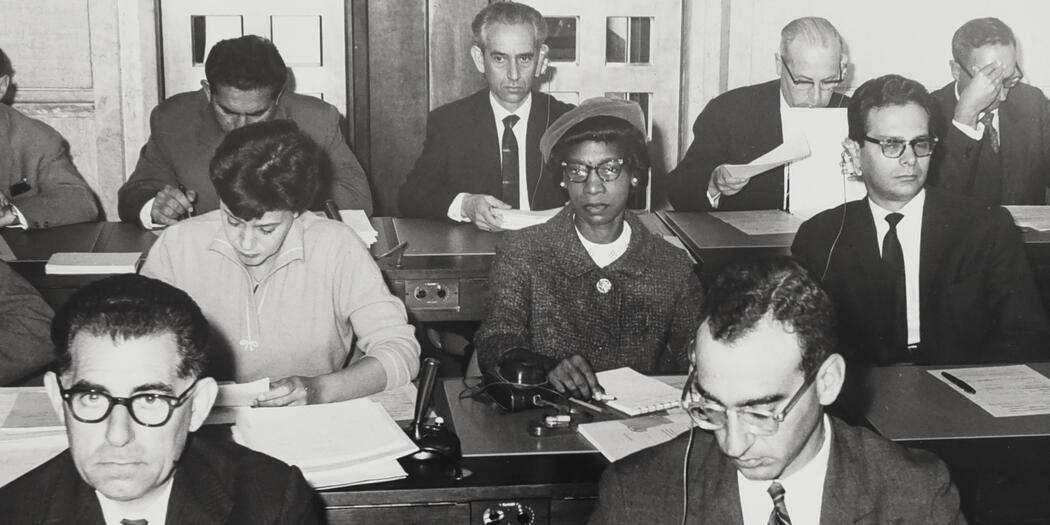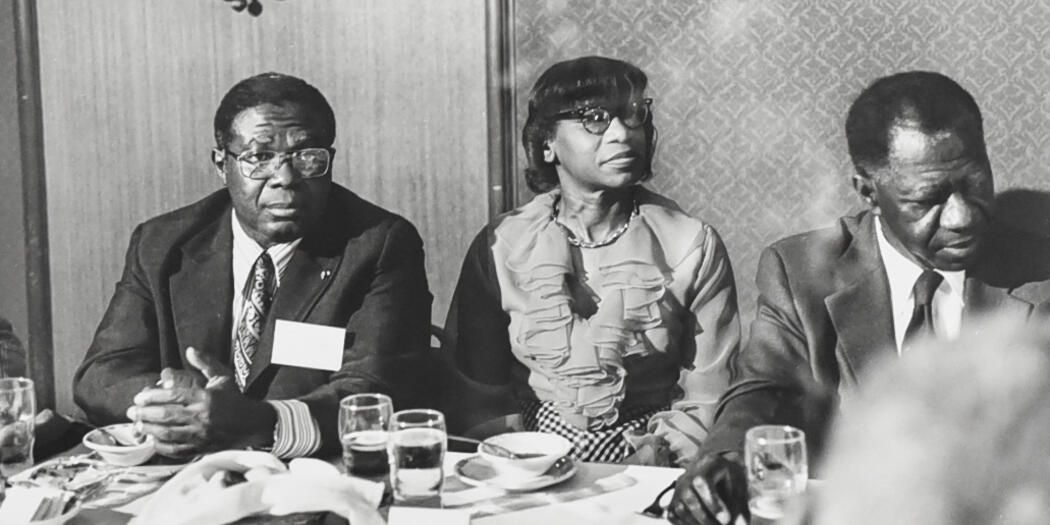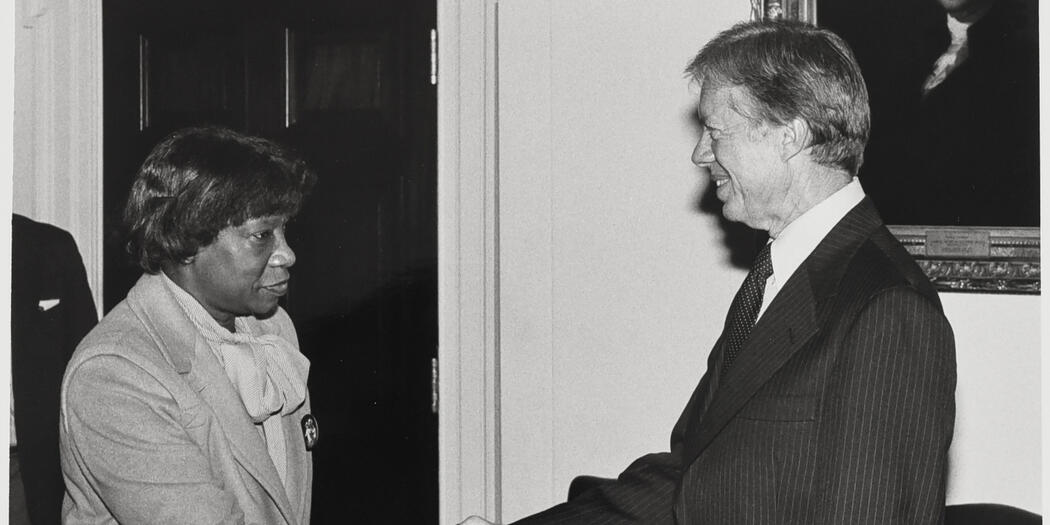Credit: Phyllis Wallace portrait 1975. Photograph courtesy of MIT Museum.
MIT Sloan’s first tenured female professor tackled workplace discrimination
Phyllis A. Wallace — the first woman granted tenure at the MIT Sloan School of Management — researched overlooked topics in the economics field and mentored young graduate students who still remember her scholarship, dedication, and generosity nearly 30 years after her death. Wallace, who died in 1993 at the age of 71, would have turned 100 this past June.
Described as “political in an understated way,” Wallace researched topics such as young Black women in the labor market, which very few academics did at that time. Wallace, who was Black, bridged academia and policy work by mobilizing others in the field of the economics of discrimination.
As recounted by colleagues and former students, Wallace dedicated her professional life to studying the data on racial and gender discrimination in the workplace.
“She is a true hidden figure of the empirical literature on race in America,” said James J. Heckman, a Nobel laureate who was influenced by Wallace.
Early life
Phyllis Ann Wallace was born on June 9, 1921 in Baltimore. She was the oldest of Stevella and John Wallace’s seven children. In 1939, she graduated as valedictorian from Frederick Douglass High School, one of the oldest public U.S. high schools created for Black students, according to Wallace’s former student Annette LaMond, SM ’74.
Following graduation, Wallace studied economics at New York University. Because the University of Maryland was segregated, the state paid out-of-state tuition for any student who wanted to study a subject not offered at the all-Black Maryland colleges. She graduated in 1943 with a bachelor’s degree in economics.
Next, at a professor’s suggestion, Wallace applied to — and was accepted at — Yale University, where she earned a master’s degree in 1944 and was the first woman awarded a doctorate in economics at Yale in 1948. Wallace’s thesis focused on international sugar agreements, and she parlayed her expertise into a stint as a researcher at the National Bureau of Economic Research, where she studied international trade. On the side, while living in New York, she taught classes at City College. She then moved to Atlanta, where she taught at Atlanta University from 1953 to 1957.
In the late 1950s, the U.S. government hired Wallace as a specialist in the Soviet economy, and some have assumed that she worked for the CIA. Little is known about Wallace’s work during this time, but as someone with an economics background who was fluent in at least five languages, she might have excelled in intelligence work. Colleagues said she was discreet about her role with the U.S. government.
AT&T discrimination case and appointment to MIT Sloan
In 1964, President Lyndon B. Johnson signed the Civil Rights Act, the landmark legislation that outlawed employment discrimination on the basis of race, color, religion, sex, or national origin. The act also banned segregation in public places such as restaurants, courthouses, hotels, and retail stores.
One year later, Title VII of the Civil Rights Act created the Equal Employment Opportunity Commission, and in 1966, the new commission hired Wallace as the chief of technical studies. The bipartisan EEOC had the power to file lawsuits on behalf of aggrieved workers, as well as protect employees who charged their employers with discrimination.
In her role, Wallace organized all of the government data that the EEOC required, and supplied it to leading young economists at the time so they could analyze where discrimination and exclusion existed. One of these upstart economists was MIT Sloan’s Lester Thurow, who said Wallace provided him with his first research grant when he was an assistant professor at Harvard University.
Wallace also contacted who was eager to dig into the EEOC data. At the time, McKersie was on the faculty of the University of Chicago, where he initiated a large research project and also used some of the data — formally known as the EEO-1 data — in his work with the Office of Federal Contract Compliance Programs at the Department of Labor. He often saw Wallace for meetings in Washington, where he met Thurow and other burgeoning economists such as Heckman and Orley Ashenfelter. Later, McKersie became dean of the New York State School of Industrial and Labor Relations at Cornell University and tried to recruit Wallace to join the faculty there; however, she declined. McKersie said Wallace — who did not drive and loved the theater and arts — enjoyed living in the city, and Ithaca, N.Y., was probably not high on her list of places to live.
Credit: International Conference on Input-Output Techniques in Geneva, with Phyllis Wallace in center, October 1961, Phyllis Wallace Papers, MC-0362, 27. Department of Distinctive Collections, MIT Libraries, Cambridge, Massachusetts
By 1969, Wallace had left the EEOC, and was hired as a vice president at Metropolitan Applied Research Center, a nonprofit that focused on urban society, according to the book “The Bellwomen: The Story of the Landmark AT&T Sex Discrimination Case” by Marjorie A. Stockford. While there, she worked with MARC founder Kenneth B. Clark and Hiram Lewis and drew inspiration for her book “Pathways to Work: Unemployment Among Black Teenage Females.” The book followed the career paths of young Black women living in New York City’s Harlem and Bedford-Stuyvesant neighborhoods. But in 1970, the EEOC recruited her back as a contract worker when it initiated a groundbreaking discrimination case against AT&T, which was the nation’s largest private employer at the time. AT&T, which employed more than 750,000 workers (more than half of whom were women), had been charged with discrimination against women and minorities.
William H. Brown III, who was chairman of the EEOC from 1969 to 1973, hired Wallace specifically to find experts to testify in the EEOC case. According to Stockford's book, by early 1971, Wallace had recruited authorities such as Ashenfelter, the professor at Princeton who was a leading researcher in the economics of discrimination as well as Cornell’s Judith Long Laws, whose research disputed the myth that women preferred low-paying work. Wallace also located two doctors who testified that women were capable of working during pregnancy.
The diligence paid off for Wallace and the EEOC. In January 1973, a consent decree was issued, and millions of dollars in back pay was ordered for women and racial minorities at AT&T. In addition, a new promotion pay policy was enacted to ensure increased wages for women and racial minorities at the company. Wallace edited a book on the case, “Equal Employment Opportunity and the AT&T Case.”
The high-profile case meant Wallace had more career opportunities than ever. In the early 1970s,who was the MIT Sloan dean from 1966 to 1980, heard Wallace give a talk about her research on Black teenage women in the labor market. Impressed with her work, Pounds invited Wallace to be a visiting professor in 1973, joining some of her old acquaintances such as Thurow, who was a professor and then later dean at MIT Sloan. Later on, in 1980, Wallace and McKersie were reunited when MIT Sloan hired him as a faculty member. McKersie was inspired to join MIT Sloan because of its esteemed industrial relations work, but said getting to work with Wallace again was “the icing on the cake.”
A generous mentor and collaborator
In July 1975, Wallace was the first woman to receive tenure, as well as the first woman appointed as a full professor, at MIT Sloan. At the school, students relied on Wallace for mentorship. Many of these former students — now economics faculty themselves — remembered her generosity and caring spirit.
“Her office was kind of an island of comfort,” said Ronald Ferguson, an economics student at MIT in the late 1970s, one of just a few Black students in the program. Ferguson remembered informal conversations based on their lives and backgrounds. Ferguson graduated with a PhD in 1981 and has been on the faculty at the Harvard Kennedy School for nearly 40 years.
Credit: Phyllis Wallace at the African-American Scholars Council, Inc., 1975, Phyllis Wallace Papers, MC-0362, 27. Department of Distinctive Collections, MIT Libraries, Cambridge, Massachusetts
Brown University’s Glenn Loury, PhD ’76, who met Wallace while he was studying economics at MIT, said she was like a second mother to him and guided him through some personal crises, including a divorce from his first wife.
Wallace was also close with Linda Datcher, an economics student who eventually married Loury. Linda Datcher Loury, PhD ’78, co-wrote “Black Women in the Labor Force” with Wallace.
Loury was a research assistant for Wallace the summer after completing his first year of studies. Following his graduation from MIT, Loury taught economics at Northwestern University, the University of Michigan, and Harvard University. When he started writing on political issues about racial discrimination for popular magazines, Wallace introduced him to civil rights leaders such as Benjamin Hooks and M. Carl Holman.
Like Loury, MIT alumna LaMond was grateful for Wallace’s generosity. She worked as a research assistant for Wallace in 1974, specifically to help prepare for a colloquium on equal employment opportunity. Wallace invited LaMond to be co-editor of “Women, Minorities, and Employment Discrimination.”
Lisa M. Lynch, a former provost at Brandeis University and now a professor there, said Wallace’s labor economics course in 1975 cemented her career plans.
Lynch recalled that Wallace once gave one of her papers an A-minus, but commented, “You need more data to back up your arguments, and a little less emotion.”
“That was classic Phyllis,” Lynch said. “She was not an easy grader, and she was looking for well-developed, data-driven, and evidence-based arguments in our papers.”
Fellow MIT Sloan faculty member remembered collaborating with Wallace in supervising PhD students. Kochan cited Casey Ichniowski, PhD ’83, who was doing “outstanding work” as a master’s student. Ichniowski was eager to get to work, but it was Wallace who convinced him to pursue a doctorate.
Both and Clarence G. Williams, who served as co-ombudsmen at MIT during the 1970s and 1980s, remembered that Wallace was a source of support for many Black MIT students and staff members. Rowe recounted numerous times when she was told that Wallace had provided “desperately needed comfort and counsel.”
Williams said Wallace was “a pillar of strength” when MIT’s small number of Black faculty members were trying to organize as a voice to be taken seriously at the Institute. Senior faculty members listened to Wallace’s advice, Williams said.
Using data to “lift the veil”
The late 1960s and early 1970s were tumultuous years in which Vietnam War protests at times turned deadly, and women and Black people struggled to earn equal treatment and pay. Those who remember Wallace recall that she was not outwardly vocal with them about issues like the Black Power movement. But Ferguson said, “She was political in an understated way. She had an agenda, and she knew what she was there for — both in academia and in her government work.”
Credit: Phyllis Wallace and President Jimmy Carter, October 1979, Phyllis Wallace Papers, MC-0362, 27. Department of Distinctive Collections, MIT Libraries, Cambridge, Massachusetts
According to Ferguson, that agenda involved research and policy work on labor market issues that economists should have been concerned about at the time, but perhaps were not devoting as much attention to as Wallace thought was warranted.
“Phyllis wasn't doing what other economists did,” Ferguson said. Wallace used her economics background to impact real-world issues, and her legacy was a subtle kind of influence that represented real power, he said.
He said Wallace — being one of the few Black people at the time having an advanced degree from an elite institution — knew how government and policy worked and strived to have influence in that realm. “She was someone who made sure that the topic of discrimination was on the agenda and something that people were studying and writing about,” Ferguson said. She was especially proud, he said, of her behind-the-scenes influence on federal employment legislation.
Loury said he and Wallace discussed discrimination “a little bit.”
“She knew that she was Black and I was Black. And, she wanted to help Black people, and was aware of the struggles,” Loury said. “My theory on that is that she had a strategy about how to succeed in white institutions, and that was through competence. She was always emphasizing competence. It’s impossible that she wouldn’t have experienced discrimination. But it was not something she wore on her chest. She was playing — this is my interpretation — she was playing the long game.”
who was hired at MIT Sloan in 1980, did not work directly with Wallace, but knew her from the small gatherings of female faculty at the school. She remembered when Wallace told the group a story about serving on a board of directors. Initially, Wallace wasn’t asked to do a lot of work, but eventually she became chair of a sub-committee and was asked to deliver a report to the full board.
“She remembered the members of the board, all white men, extravagantly praising her report, which she considered competent, but not extraordinary,” Yates said. “To her, this demonstrated that they hadn’t expected her to be able to perform this task competently, and were surprised when she did.”
Described as a “quiet revolutionary” by Lynch, Wallace was an economist who “used data to lift the veil on what was actually happening in the labor market” at the time. Lynch pointed to Wallace’s work studying young Black women because they were a group in the labor market that researchers ignored at the time.
“Phyllis used to say, ‘If you want to understand the labor market, and the most vulnerable people in the labor market, you need to look at what’s happening to young Black women,’ and that’s a refrain you hear today,” Lynch said.
Retirement and community activities
In 1982, Wallace received the Samuel Z. Westerfield Award, which the National Economic Association gives out every three to five years to a Black economist with a “distinguished record throughout their career of scholarship, teaching, and public service.”
Wallace retired from MIT Sloan in 1986, and MIT hosted a conference to celebrate her.
In retirement, Wallace kept busy with the things that mattered most to her. She was passionate about the arts and was appointed as the MIT representative to the Boston Museum of Fine Arts Board of Trustees in 1976 and served for seven years. She was the first Black woman elected to the MFA Board. Both McKersie and Lynch remembered that Wallace wanted to ensure that the MFA was an inviting place for the broader community, especially minorities.
Later, Wallace helped establish the gallery for Nubian art, “Nubia: Ancient Kingdoms of Africa,” which was on view from 1992 to 2006, and generously provided funds for the MFA to give copies of the book “Nubia: Ancient Kingdoms of Africa” free to schools, libraries, teachers, and community centers in the Boston area.
In 1988, Wallace was the first woman and the first Black person to serve as president of the Industrial Relations Research Association. She hosted dinners at her Back Bay apartment and stayed in close contact with many of her former MIT students. Just before she died, she had agreed to help Dean Thurow investigate ways to deal with sexual harassment claims at MIT Sloan.
Wallace’s death, legacy
On January 10, 1993, Wallace died in her home in Boston at the age of 71. Her mother, several siblings, and nieces and nephews survived Wallace. A memorial service was held in Boston, where McKersie, Thurow, and many others gave tributes.
Wallace’s lasting legacy may be in her understated yet dogged determination to improve the world. At her memorial, Thurow said, “The title of her book, ‘Pathways to Work,’ in many ways was a fitting title for her academic career. She wanted to understand existing pathways to work, change pathways to work, and help those who were discriminated against find pathways to work. She was concerned, understood discrimination, and at the same time was hard-nosed about the need to make an effort regardless of the fairness or unfairness of the obstacle put in one’s way.”
Ferguson said, “I think her legacy is all the people she influenced … . She mobilized researchers to address the issues that she thought were important, and she mentored young people.”
Heckman, who won the Nobel Memorial Prize in Economic Sciences in 2000, agreed with Ferguson, and counted himself as one who Wallace mobilized. “She had a commanding view of an emerging field and help shape it, and encouraged the use of evidence on issues of compliance with the law … . She encouraged young scholars across diverse racial and academic backgrounds, [and] I learned a lot from her. She was serious and at the same time very gracious, genial, and engaging. A very decent human being and a serious scholar.”
Continuing Wallace’s work
A decade after the EEOC was formed, Wallace knew the work on inequality in the U.S. employment market was not finished. In a 1976 article in Black Enterprise, Wallace wrote, “Although black workers experienced some improvement in occupational status between 1962 and 1976, their share of the better jobs was frequently below their representation in the qualified labor force. After more than a decade of implementation of laws and regulations prohibiting racial discrimination in employment, discrimination in the workplace is still pervasive.”
Related Articles
There has been progress, although some of the challenges have shifted, according to economists such as Ferguson. A gap remains between white and Black unemployment rates.
“If you think about the biggest reasons that people of color don’t have access to employment opportunities today, it’s a skills issue,” Ferguson said. “Back then [1960s, 1970s] there were still skills issues, but there was blatant discrimination as well … of ‘we don’t hire people of color.’ And so, back then it was about making them open the door to let in the folks who are qualified. Today, a lot of doors are open, but the struggle is finding people who are prepared to walk through those doors … . So, we still have to make sure the doors stay open.”
who was the second woman to earn tenure at MIT Sloan, said things may have improved for Black Americans, but it is not enough.
“Social change is slow, but it is particularly slow on this issue because we haven’t yet come to a consensus that there is a problem and because solutions that help one group seem to hurt others — an either-or point of view,” Bailyn said. “Instead of enlarging the pie, we assume it is fixed and what one group gains another loses. An excellent counter-example is gay marriage, which is generally accepted nowadays by the American public. The realization came fairly quickly that this only enlarges the pie and in no way takes away from marriage between a man and a woman. We haven’t gotten there yet on race, and it isn’t as obvious there. So that’s another issue that is keeping things on such a slow track.”
“I agree with Lotte,” Kochan said. “She points to the underlying fixed pie view. I would add [that] we have not done enough to empower Black Americans to take charge of breaking the cycle of poverty and exclusion in our own institutions — in business, labor, academia, or government. Real and sustained progress will come only when we have sufficient Black leaders in positions of real power and influence.”
Lynch, who has served as a visiting scholar at MIT Sloan, said coming to terms on this will not be easy, especially with society’s polarization. “I say that as an economist and as somebody who spent time as a policymaker in Washington. I don’t think it’s a question of even just consensus … I think we have a huge abyss in opinions that people are not sharing and talking to one another. This would be a moment where Phyllis would say, ‘Let’s look at the data. Let’s look at the evidence.’”
If Wallace were alive today, Lynch speculated, she would be likely be interested in the work scholars like Harvard professor Raj Chetty are doing on the racial wealth gap. “Raj’s work has really brought to the discussion of why racial gaps exist … we’ve certainly learned that the racial wealth gap … acts as a lodestone and pulls people back from the starting line. It’s something that persists across lifetimes and across generations.
“Phyllis believed business and managers could and should be important social change agents and use their power and influence to address inequities in the economy,” Lynch said. “That is why being at Sloan was so important for the impact she had — as a teacher and a scholar activist she could engage with the current and future leaders of business about this.”






